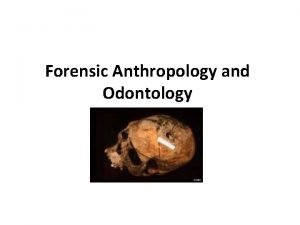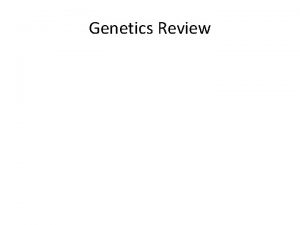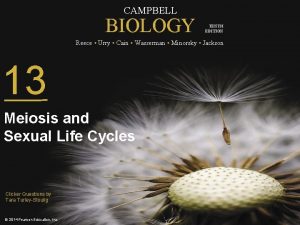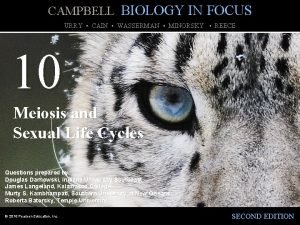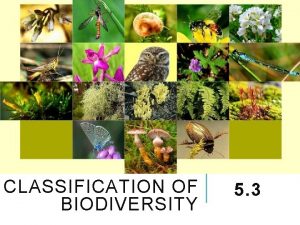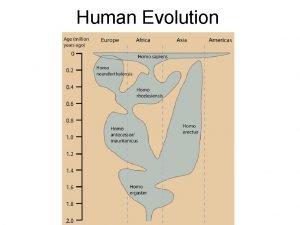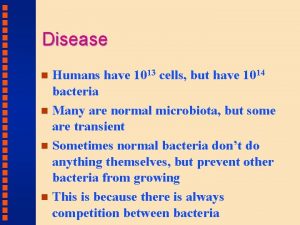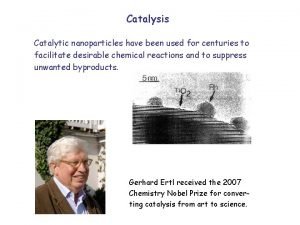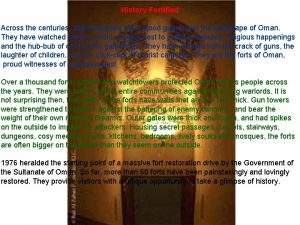5 3 Classification Classification For centuries humans have










































































- Slides: 74

5. 3 Classification

Classification § For centuries, humans have been attempting to classify the various species on Earth in order to learn more about the species and their evolutionary history. § Classification attempts to group more related species together

Binomial system of Nomenclature § A “ 2 name” naming system that was designed by Carolus Linneaus in the 18 th century.

Binomial System of Nomenclature § Every species has a Latin name, § The first part of the name is the name of the genus, the second part is the species. § The name is printed in italics § If hand written, underline the name § The first letter of the genus is capitalized § The first letter of the species is not

Examples: § Humans: Homo sapiens GENUS SPECIES § Dogs: Canis lupus familiaries SUBSPECIES

§ Linnaeus’ system was largely based on morphology and is not the best way to classify organisms § (Modern methods use evolutionary relationships to classify organisms) § However, Linnaeus’ system is still the basis of how we name organisms today.

International Cooperation & Classification § Scientists all around the world use the binomial system as a universal naming system to identify a species rather than the many local names

Arum maculatum

Arum maculatum local names § England: § Lords-and-ladies § Cows and bulls § Devils and angels § France: § la chandelle § Le pied-de-veau § Spain: § Comida de culebra § Alcatrax § Dragontia menor § Vela del diablo

Hierarchy of Taxa § Taxonomists classify species using a hierarchy of taxa § TAXON = group of something § Taxon (singular), taxa (plural) § The taxa form a hierarchy, as each taxon includes taxa from the level bellow

Three Domains § Traditional classification systems have recognized 2 major categories of organisms based on cell types: eukaryotes and prokaryotes § Think back to Topic 1 in grade 11. Do you remember the difference?

Three Domains § Because prokaryotes are so diverse, most classifications systems recognize 3 major categories or domains § Eubacteria (bacteria) § Archaea (archaeans) § Eukaryota (eukaryotes) Types of prokaryotes

Comparing the 3 domains § See page 261 of text

Histones Associated with DNA BACTERIA ARCHAEA EUKARYOTA absent Proteins similar to histones bound to DNA Present

Presence of Introns BACTERIA Rare or absent ARCHAEA Present in some genes EUKARYOTA Frequent

Structure of Cell Walls BACTERIA Made of chemical peptidoglycan ARCHAEA Not made of peptidoglycan EUKARYOTA Not made of peptidoglycan, not always present

Cell Membrane Difference BACTERIA Glycerol-ester lipids; Unbranched side chains; D-form of glycerol ARCHAEA Glycerol-ether lipids; Unbranched side chains; L-form of glycerol EUKARYOTA Glycerol-ester lipids; Unbranched side chains; D-form of glycerol


Archaeans § Found in a broad range of habitats: § § § Ocean surface deep ocean sediments oil deposits below the Earth’s surface High salt concentrations High temperatures § Ex: methanogens which live in the intestines of cattle and produce methane as a waste product.



Hierarchy of Classification for Eukaryotes § Seven level hierarchy of taxa to classify organisms § Kingdom § Phylum § Class § Order § Family § Genus § Species

§ King Phillip Coughs. Oh! Filthy Germs Spread!!!

Kingdoms § Kingdoms are the broadest category § Originally there were only 2 Kingdoms: Plants and Animals § Today, we have identified 5

Modern Kingdoms § § Kingdom Plantae (plants) Kingdom Animalia (animals) Kingdom Fungi (fungi and moulds) Kingdom Protoctista (protozoa and algae – includes paramicium and amoebas) § Kingdom Prokaryotae (bacteria)

Examples of Classification § You need to know an example of 1 plant and 1 animals species from domain to species level § See page 262 for an example of the grey wolf and the date palm

Ex: Humans KINGDOM Anamalia PHYLUM Chordata CLASS Mammalia ORDER Prima FAMILY Hominidae GENUS Homo SPECIES sapiens

Ex: Garden Pea KINGDOM Plantae PHYLUM Angiospermae CLASS Dicotyledoneae ORDER Rosales FAMILY Papilionaceae GENUS Pisum SPECIES sativum

Natural Classification § The genus and accompanying higher taxa consist of all the species that have evolved from one common ancestor § Because of the common ancestor we can expect the members of a natural group to share many characteristics


Natural vs Artificial Characteristics § Plants and fungi were one time classified together because they both have cell walls, but this is an artificial classification as their cell walls evolved separately and molecular research shows they are no more similar to each other than to animals.


Natural vs Artificial Characteristics § Ex: wings of insects, birds, and bats § We will come back to this when we talk about convergent evolution and analogous traits.

Reviewing Classification § Sometimes taxonomists reclassify species when new evidence shows that a previous taxon contains species that have evolved from different ancestral species § The new evidence is usually DNA sequencing

Advantages of Natural Classification § Natural classifications help in identification of species and allow the prediction of characteristics shared by species within a group

Plants § All plants are found in a single kingdom § During the life cycle of a plant, male and female gametes develop and fuse to form a zygote, which will develop into an embryo and then the particular plant

Expectation, page 266 § Distinguish between the following phyla of plants using simple external recognition features § Phyla: bryophyte , filicinophyta, coniferophyta, angiospermophyta

Bryophyta § Mosses and liverworts § Small terrestrial plants that do not have true roots, stems or leaves (but may have similar structures) § Leaf-like structures arranged in a spiral § Usually live in clusters


Filicinophyta § Ferns § Have true leaves § New leaves unroll § Have an underground creeping stem (called a rhizome)


Coniferophyta § Conifers § Woody plants, with a single wooden trunk and side branches § Leaves are long thin needles and dark green § Produce seeds in cones


Angiospermophyta § Angiosperms/ Flowering Plants § Have flowers § Seeds are in ovaries with become the fruit § Leaves usually as a leaf blade and a leaf stalk, with veins visible on the lower surface


Animal Phyla § Animals are divided into over 30 phyla § Distinguish between the following phyla of animals, using simple external recognition features. (see page 267)

Porifera § Sponges § Most primitive animals with a simple body § Live in water § Do not move around § No mouth, but have small holes through which water is pumped into body and have be filtered for food before pumping out


Cnidaria § Jellyfish and sea anemones § Have stinging cells § Radially symmetrical § Have a gastro-vascular cavity (a hollow space in the centre of the body) with only one opening to the cavity § Often have tentacles around the opening


Plathyelminthes § Flatworms § Soft flattened body with a definite head region § Bilateral symmetry § Gastro-vascular cavity § Usually one opening to cavity § Live in water or damp environments § Can be free-living or parasitic


Arthropoda § Animals with jointed legs § Ex: insects, arachnids, crustaceans § Exoskeleton made of chitin (a polysaccharide) § Segmented body § Appendages to each segment § At least 3 pairs of legs § May be free living or parasitic


Annelida § Worms and leeches § Bodies of ring-like segments § Have a mouth and an anus § Live in water or moist soil § May be free living or parasitic § No legs § Bristles from body which help them move


Mollusca § Snails, squids, clams, slugs § Soft unsegmented bodies § May have a shell


Chordates - Vertebrates § All are vertebrates because they have a backbone composed of vertebrae § There are 5 major classes of chordates § You need to recognise the features of birds, mammals, amphibians, reptiles, and fish (page 268)

Birds § § Skin with feathers made of keratin 2 legs, 2 wings Females lays eggs with shells Maintain constant body temp

Birds

Mammals § Skin with follicles with hair made of keratin § Lungs with alveoli, ventilated used ribs and diaphragm § Give birth to live young and all feed young with milk from mammary glands § Maintain constant body temperature

Mammals


Amphibians § Soft moist skins permeable to water and gases § Simple lungs with small folds and moist skin for gas exchange § 4 legs as an adult § Larval stages lives in water and as an adult usually lives on land § Do not maintain constant body temp

Amphibians


Reptiles § Impermeable skin covered in scales of keratin § Lungs with extensive folding to increase the surface area § Female lays eggs with soft shells § Do not maintain constant body temp

Reptiles


Fish § § Scales with are bony plates in the skin Gills No limbs Remain in water throughout their life cycle § Do not maintain constant body temp

Fish

Dichotomous Keys § Apply and design a key for a group of up to eight organisms. § Keys are most commonly used to identify plants, insects, and birds. § You need to be able to construct a dichotomous key page 265

 Ntative
Ntative For centuries prominent thinkers have pondered
For centuries prominent thinkers have pondered For many years people have wondered
For many years people have wondered How many chromosomes do humans have
How many chromosomes do humans have How many chromosomes in human
How many chromosomes in human How many teeth do adults have on top
How many teeth do adults have on top How many chromosomes do humans have
How many chromosomes do humans have How many senses do humans have
How many senses do humans have How many pairs of chromosomes
How many pairs of chromosomes Privet shrubs and humans each have a diploid number of 46
Privet shrubs and humans each have a diploid number of 46 Privet shrubs and humans each have a diploid number of 46
Privet shrubs and humans each have a diploid number of 46 Notch of the manubrium
Notch of the manubrium The fundamental theme through all the centuries
The fundamental theme through all the centuries A few centuries ago
A few centuries ago Capital of niger
Capital of niger What has 6 faces 12 edges and 8 vertices
What has 6 faces 12 edges and 8 vertices Kingdom phylum class order of humans
Kingdom phylum class order of humans Iso 22301 utbildning
Iso 22301 utbildning Typiska novell drag
Typiska novell drag Nationell inriktning för artificiell intelligens
Nationell inriktning för artificiell intelligens Vad står k.r.å.k.a.n för
Vad står k.r.å.k.a.n för Varför kallas perioden 1918-1939 för mellankrigstiden?
Varför kallas perioden 1918-1939 för mellankrigstiden? En lathund för arbete med kontinuitetshantering
En lathund för arbete med kontinuitetshantering Kassaregister ideell förening
Kassaregister ideell förening Personlig tidbok
Personlig tidbok Anatomi organ reproduksi
Anatomi organ reproduksi Förklara densitet för barn
Förklara densitet för barn Datorkunskap för nybörjare
Datorkunskap för nybörjare Tack för att ni lyssnade bild
Tack för att ni lyssnade bild Debattartikel mall
Debattartikel mall Magnetsjukhus
Magnetsjukhus Nyckelkompetenser för livslångt lärande
Nyckelkompetenser för livslångt lärande Påbyggnader för flakfordon
Påbyggnader för flakfordon Tryck formel
Tryck formel Offentlig förvaltning
Offentlig förvaltning Jag har gått inunder stjärnor text
Jag har gått inunder stjärnor text Presentera för publik crossboss
Presentera för publik crossboss Jiddisch
Jiddisch Bat mitza
Bat mitza Klassificeringsstruktur för kommunala verksamheter
Klassificeringsstruktur för kommunala verksamheter Luftstrupen för medicinare
Luftstrupen för medicinare Bästa kameran för astrofoto
Bästa kameran för astrofoto Cks
Cks Byggprocessen steg för steg
Byggprocessen steg för steg Mat för unga idrottare
Mat för unga idrottare Verktyg för automatisering av utbetalningar
Verktyg för automatisering av utbetalningar Rutin för avvikelsehantering
Rutin för avvikelsehantering Smärtskolan kunskap för livet
Smärtskolan kunskap för livet Ministerstyre för och nackdelar
Ministerstyre för och nackdelar Tack för att ni har lyssnat
Tack för att ni har lyssnat Referatmarkeringar
Referatmarkeringar Redogör för vad psykologi är
Redogör för vad psykologi är Stål för stötfångarsystem
Stål för stötfångarsystem Atmosfr
Atmosfr Borra hål för knoppar
Borra hål för knoppar Vilken grundregel finns det för tronföljden i sverige?
Vilken grundregel finns det för tronföljden i sverige? Beräkna standardavvikelse
Beräkna standardavvikelse Tack för att ni har lyssnat
Tack för att ni har lyssnat Steg för steg rita
Steg för steg rita Vad är verksamhetsanalys
Vad är verksamhetsanalys Tobinskatten för och nackdelar
Tobinskatten för och nackdelar Toppslätskivling dos
Toppslätskivling dos Datumr
Datumr Egg för emanuel
Egg för emanuel Elektronik för barn
Elektronik för barn Plagg i rom
Plagg i rom Strategi för svensk viltförvaltning
Strategi för svensk viltförvaltning Kung som dog 1611
Kung som dog 1611 Ellika andolf
Ellika andolf Sju för caesar
Sju för caesar Tack för att ni lyssnade
Tack för att ni lyssnade Matte större än tecken
Matte större än tecken Texter som rimmar
Texter som rimmar Inköpsprocessen steg för steg
Inköpsprocessen steg för steg Rbk fuktmätning
Rbk fuktmätning





